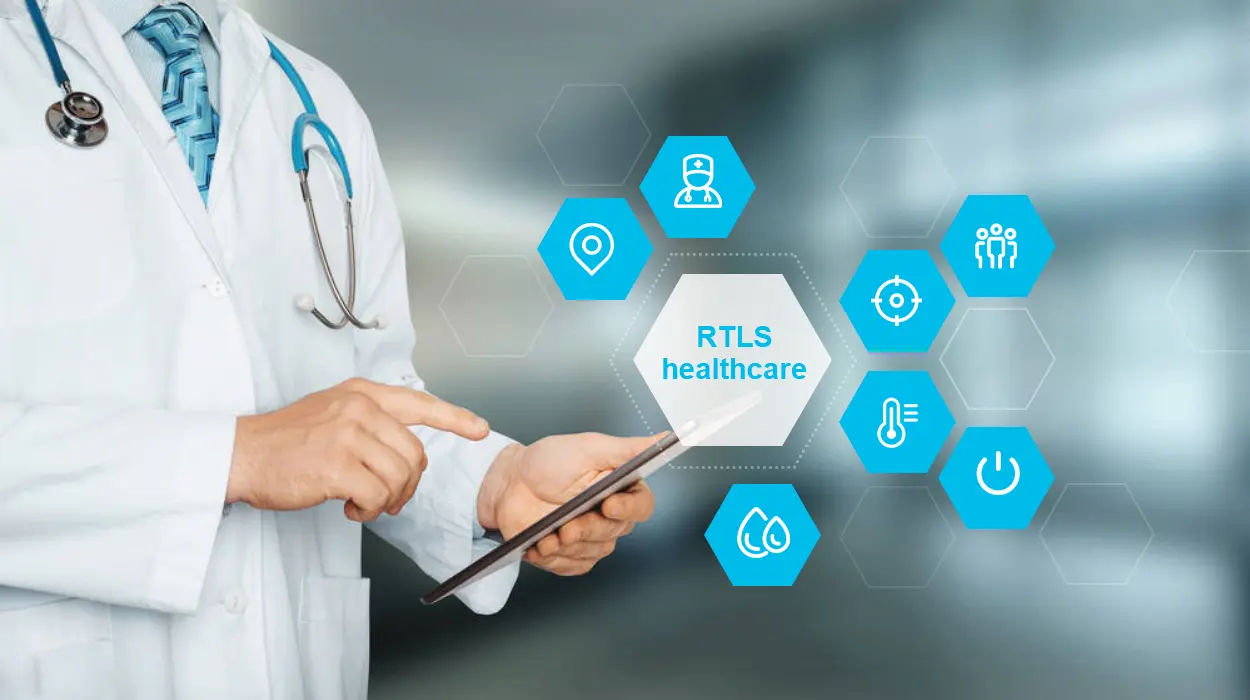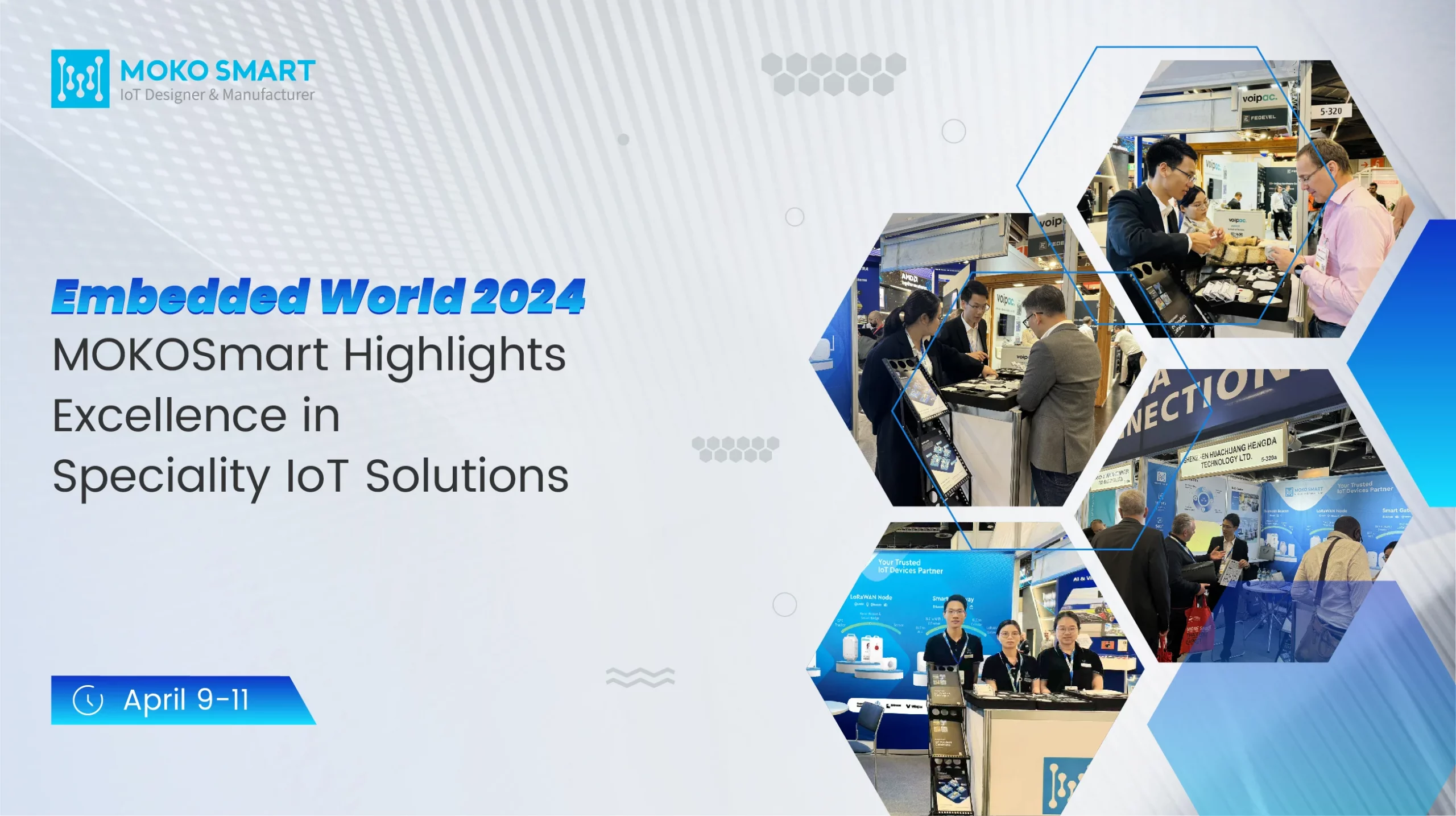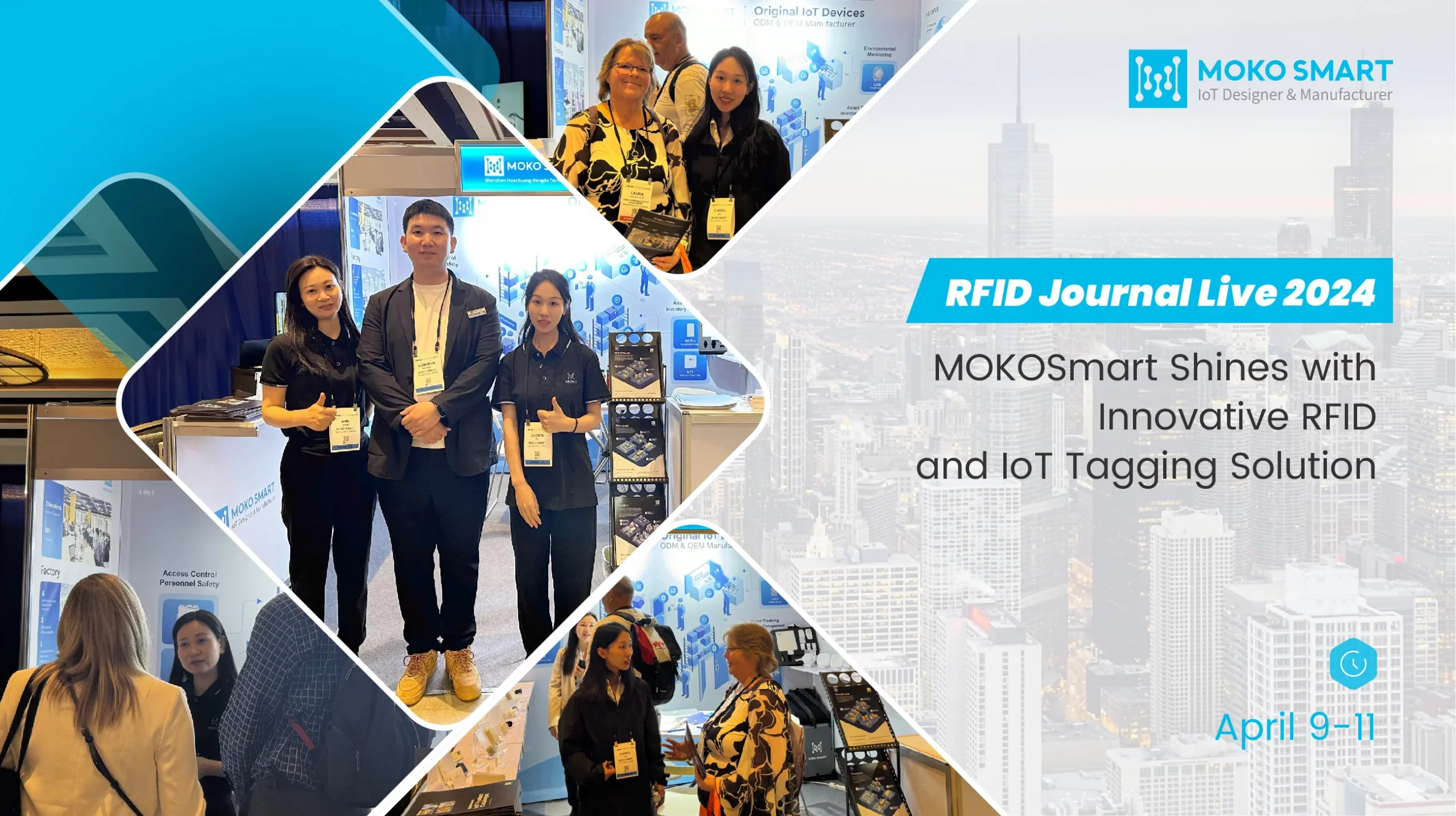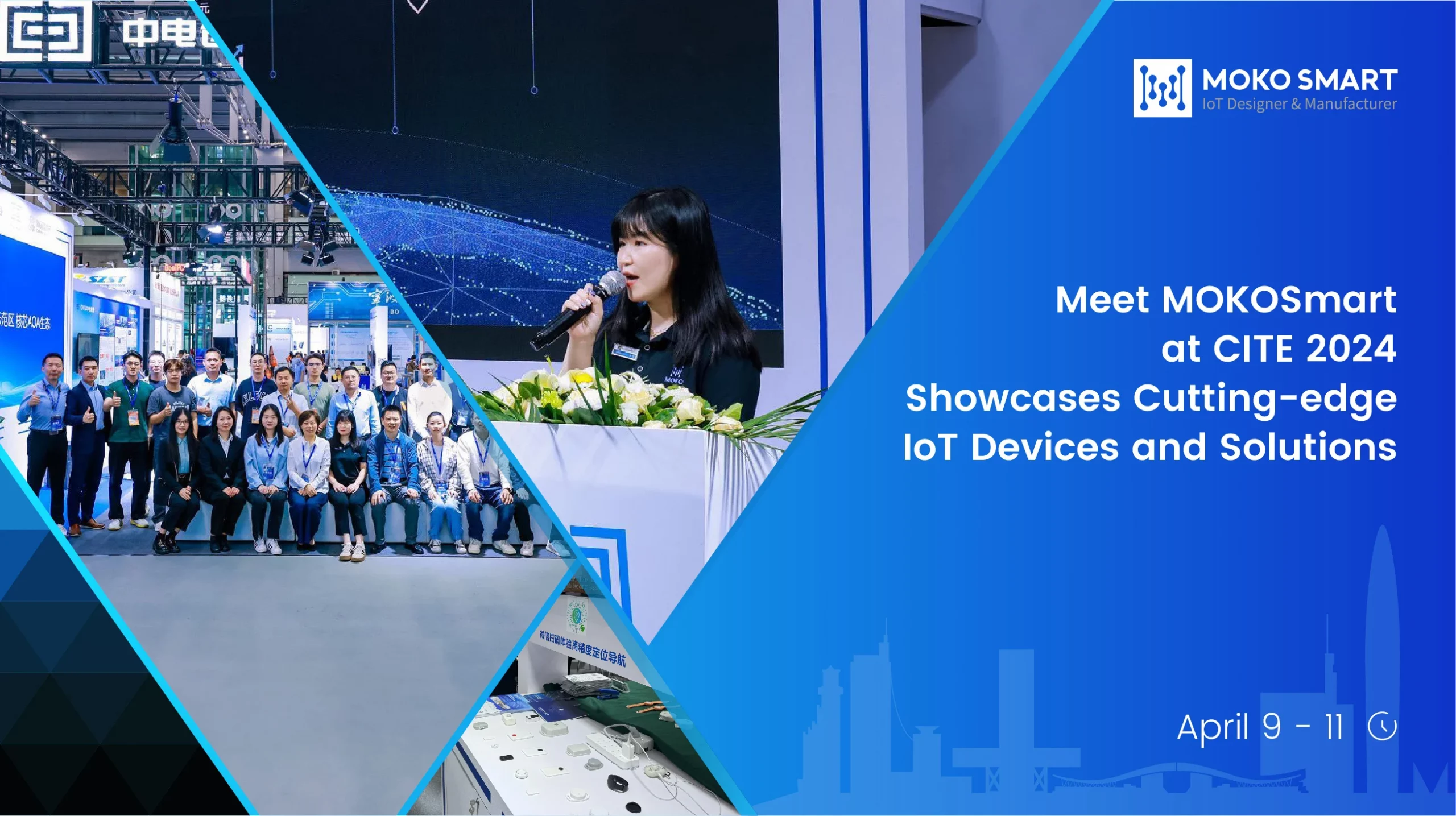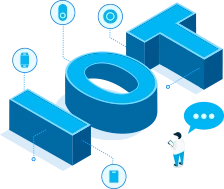Real-time Location System(RTLS) healthcare solutions
Healthcare executives have been wrestling with issues such as facility safety, employee satisfaction, quality of care provided to patients, and costly workflow inefficiencies that affect their bottom line. Often, IT innovation in healthcare is considered a potential way for improvement. Innovators are striving for creating IoT technologies that both advance patient safety and support simplified business operations. So what are the latest and most effective ways to address these challenges? Today we’re going to introduce you how to Integrate real-time Location system (RTLS) healthcare solutions into hospital processes.
What is RTLS healthcare?
RTLS healthcare system is designed to provide real-time monitoring and management of patients, medical equipment, staff members. Although the technology is different from the location data obtained using satellite triangulation, it can be thought of as a kind of indoor GPS for hospitals. However, in addition to locating assets, precision location technology can be easily integrated with other healthcare IT solutions, enabling facilities to improve workflows, reduce costs, and improve clinical quality. RTLS healthcare solutions include technology platforms (Wi-Fi, infrared, Bluetooth low energy, and low frequency, etc.), a variety of tags and badges, hardware infrastructure (readers, amplifiers,Exciter) and other components (servers, middleware, and amplifiers,End-user software).
RTLS healthcare technology typically include location sensors connected to various assets. The system can track where the sensor tag is and update you with real-time information about its location within the facility with a unique ID. Evaluation-based RTLS solutions can be tracked from unit to floor in a hospital, while clinical-grade location-based systems automated the room, bed, compartment and even shelf-level tracking.
Addressing healthcare needs
Hospitals face business problems similar to those of any other large organization. Automated monitoring and data intelligence collection for reporting and analyzing facility processes enables healthcare executives and senior managers to respond quickly and prevent barriers associated with the following programs.
1. Infection control
2. Compliance report
3. Increase the cost
4. Readmission rate
5. The nurse rounding
6. The data collection
7. Patient throughput
8. Equipment contract
9. Capital spending
10. Asset tracking
11. Compliance report
12. Rates of re-hospitalization
13. Employee safety and shortage
Use RTLS healthcare system for enhancing the safety of staffs and patients
There are many potential safety risks in hospitals,such as devices errors,infections,physical attacks and malpractices. Example of our RTLS healthcare solutions are as below:
There’s a example of malpractice that could have been avoided using an RTLS solution, in which 11 patients died from infections due to the uncleaned duodenoscopes at a hospital in Pasadena, California. But if the hospital had carefully reviewed the reprocessing and storage of duodenoscopes, then the future infections can be avoided. MOKOSmart RTLS healthcare solutions uses clinical-grade real-time Location System to automatically track and alerts during the cleaning process. Staff can immediately know when cleaning medical areas is required and are notified of any possible risk of infection in the meanwhile.
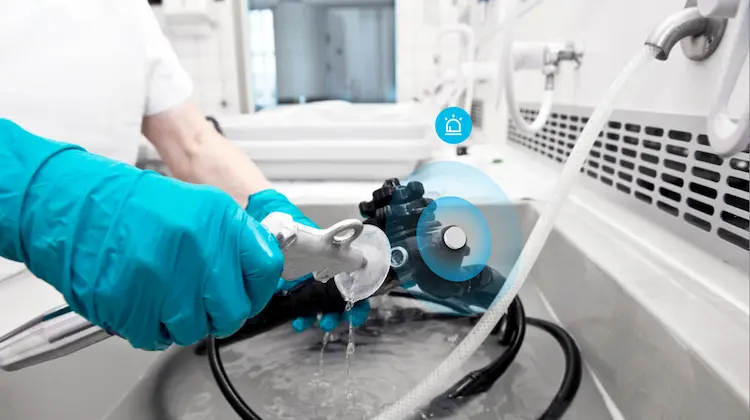
Protect the bottom line in hospital by improving the patients’ satisfaction
Real time location system can not only be helpful for patient safety, but also for satisfaction. Since the Affordable Care Act attaches medicare reimbursement to patient satisfaction surveys, the Patient satisfaction has become increasingly essential. By 2012, hospitals that did poorly in the survey could lose 1 percent of the previous year’s costs; Since 2017, the risk has been 2%.
Tracking patient processes for throughput management can help identify and resolve bottlenecks. Appropriate solutions for common problems leading to patient complaints can be customized and monitored, including:
- Long waiting times.
- Emergency rooms, outpatient clinics, and post-anaesthetic care wards are overwhelmed.
- Postpone or reschedule surgery.
- There aren’t enough beds for patients.
There’s plenty of room for unnecessary delays or errors when it comes to x-rays, walking around for recovery or switching between perioperative milestones. With real time location information, departments can operate more efficiently so as to reduce patient stress during their hospital stay.
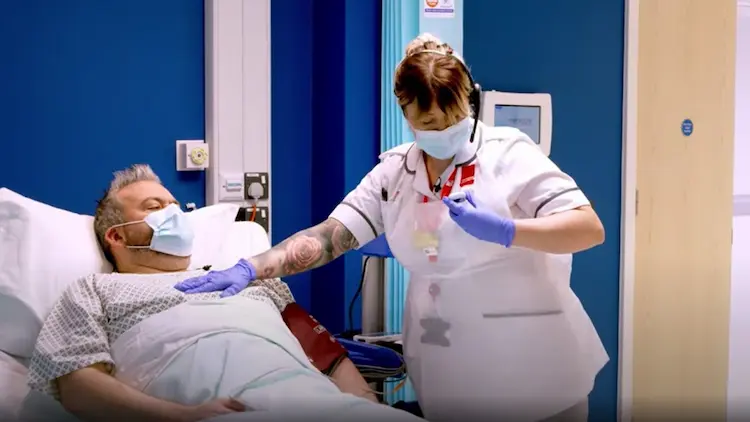
Keep costs down with strengthened health care analysis
Real time location system can also be helpful in integrating data systems and simplifying information across the health system.
This can make much contribution when you’re considering hospital business processes. Let’s look at several examples of trends that RTLS can help you measure:
- Utilization of different hospital equipment to reduce rental demand and costs
- The amount of time a patient waits to see a particular service or doctor
- The time length of a patient staying in the hospital
- Time spent on other treatments and clinicians
Reduce unnecessary costs by applying real time location system into hospitals.
International Journal of Health Geographics predicts that hospitals purchase 10 to 20 percent of more portable devices than the operation required.
Some things, like ICU ventilators, are very expensive. You can decrease the amount of asset surplus by purchasing the optimal number on the basis of utilization and having hospital RTLS track these machines. It only only reduces costs but also save your clinician time when the device is always where it should be.
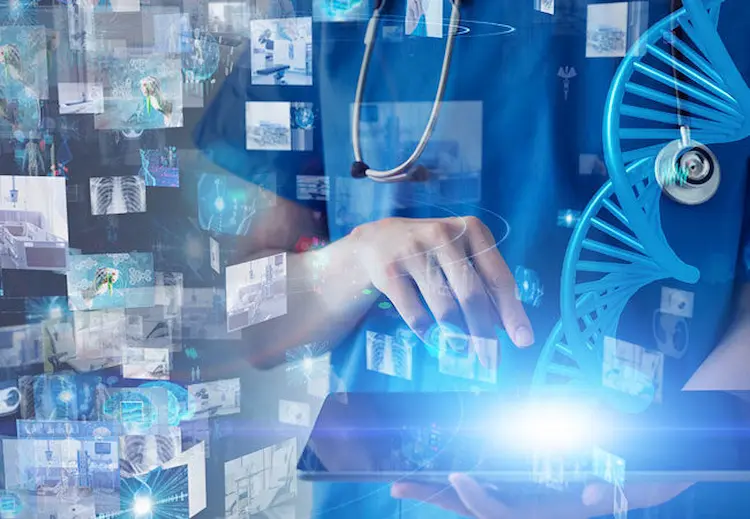
Locate the people and asset you need instantly
Different RTLS technologies can provide different levels of accuracy depending on the degree of need. Sometimes what you need to know is whether a device is positioned in the right units. In other cases, you may need to know if the surgeon has entered the operating room or if the nurse has a close relationship with the patient requesting urgent nursing assistance. The levels of positioning accuracy include:
- Locate at entry or exit point: Using our Bluetooth tags, you can determine the route that different tags move through the entry or exit point.
- Presence based positioning: At this level, RTLS can determine if a label is within a parameter over a fairly wide network.
- Room-level location: You can determine if a label is within the scope of a room. If a nurse must call for emergency aid, RTLS healthcare system can tell the security personnel the exact room the nurse is in.
- Sub-room level location: With RTLS, you can know exactly how long a nurse has been in a room with a particular patient, or you can determine where a device is in that room. When you have rooms shared by multiple patients, it can do you much favor.
- Accurate positioning: In a hospital environment, accurate positioning can be found on a detailed plan to locate the exact location of the label. Rapid location and status updates accurately capture interactions between devices, patients, and staff in seconds, facilitating collection of clinical milestones and automating workflows.
![]()
Have more work done with less labor
There is a growing shortage of staff in the hospital system. According to the 2015 AMN Healthcare survey of registered nurses, there are 62% of nurses over 54 said they were considering retirement within the next three years. In addition to nursing, there is a shortage of doctors in other basic hospitals, including operating room doctors, neonates and intensive care units. Institutions have to resolve these shortages by optimizing existing resources while continuing to provide high-quality care.
RTLS healthcare can help mitigate the impact of shortages and help hospital administrators do more with less. Here’s how RTLS can make some contribution to some critical areas in hospitals.
- Operating room: Automated events and documentation, such as tracking case status, milestones, patient locations, and departmental work queues, can provide quick insight into departments. Stress can be reduced with increasing efficiency. Surgical departments can reduce the time spent finding assets, greatly optimizing staff utilization by using RTLS healthcare solutions.
- Intensive Care Unit (ICU) Finding equipment and assets as quickly as possible can actually be the difference between life and death. Staff under pressure may not have enough time to find the required assets. RTLS healthcare solutions from MOKOSmart is capable to pinpoint the exact location of resources with 100% accuracy. When clinicians are able to complete their work without being interrupted by the challenges of misaligned devices, they enjoy a more seamless workflow. It also leads to additional job satisfaction.
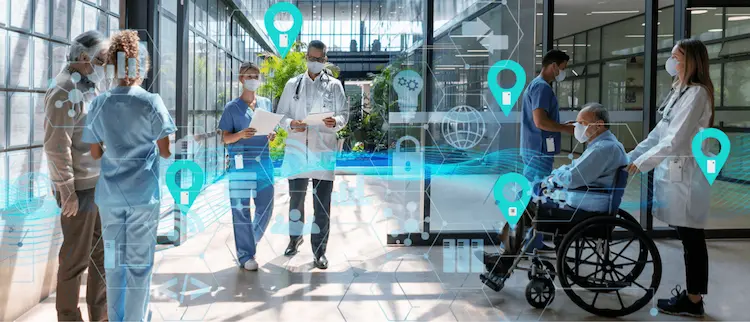
MOKOSmart RTLS healthcare Solution with Clinical-Grade Visibility™
Several key features of MOKOSmart’s clinical-grade visibility technology making this solution be the most accurate hospital location system:
Positioning accuracy
Most RTLS systems locate assets by estimating zone decomposition facilities. However, the ability to define clinical areas according to the specific needs of the healthcare facility makes the visibility system more accurate. Knowing that the items are on a particular floor or unit, rather than knowing which room or shelf they are in, is an important aspect of accuracy. MOKOSmart is able to divide the space into appropriate areas to provide accurate location visibility. Nursing stations, wards, beds, corridors and compartments are clinically essential and therefore it’s the most useful solution for medical applications.
Update speed
Accurate location only timely delivery is useful. In a hospital, things and people can move quickly, so MOKOSmart’s platform is updated accordingly. For some devices, update speed may not be important because they don’t move very often. In this case, the update rate is customizable to optimize label battery life. Bluetooth beacon sensor captures the interaction between equipment, patients and staff by quickly conveying information about their condition and location. Collect clinical milestones in seconds.
Liability
Low battery and hardware failures can disrupt the work and operational flow of the entire facility. Our RTLS healthcare solutions provides key condition, location, and status updates to the software application. Complete visibility can be seen at a glance thanks to enterprise-class equipment and tags equipped with long-lasting batteries, medical facilities will also be notified when the battery is low, in this way, you can ensure proper maintenance and prevent asset loss.
Condition monitoring
Materials that demand strict temperature and humidity control must be carefully stored and transported. Collecting data on the environmental conditions of these items is essential to ensure that they remain safe and viable for use. Beside from location, this information also needs to be recorded and provided to the appropriate personnel for complying with regulations.
Through automated environmental monitoring and drug temperature monitoring, MOKOSmart’s Bluetooth beacons ensure the safety of critical drugs, blood, laboratory samples and vaccines and are ready for patient use and maintain a record of their storage temperature and conditions.
Installation
Installing a systems that require a lot of hard wiring can be costly and time-consuming. With the easy installment of battery-powered devices , you don’t need to close a room or require special infection prevention measures. MOKOSmart’s wireless infrastructure features flexible batteries that can be easily replaced in the field, providing enterprise-level monitoring and visibility for healthcare facilities.
Interoperability
Integration with other systems is a major advantage of a positioning technology platform. Healthcare facilities involved with many independent systems,which operate in certain departments or around the entire facility. The best RTLS systems work with existing software and hardware so that can be easy to parse all the data required to make a decision.
MOKOSmart easily integrates more than 130 healthcare applications, including computer maintenance management, electronic medical records, nurse calling, and other security and access systems that your facility may already have installed.
Integration: When you try a new technology, IT can be a barrier, and for good reason. Every additional technology that is added to your network (or your customer’s network) poses a potential security risk. However, MOKOSmart does not touch your network in any way (and can be retrieved via cellular).
Scalability :MOKOSmart does not require a huge upfront investment; It can scale from one location to 10,000 locations. We’ve already seen medical centers start using our RTLS healthcare system only in operating rooms, and then expand to the entire hospital as needed. Or, if you want to study patient/provider interactions, you can just follow the providers in the study.
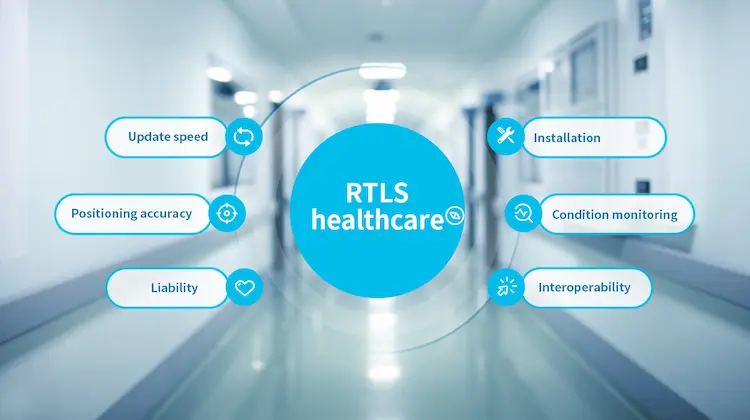
Key Resources Location Accuracy
Estimated location of critical resources
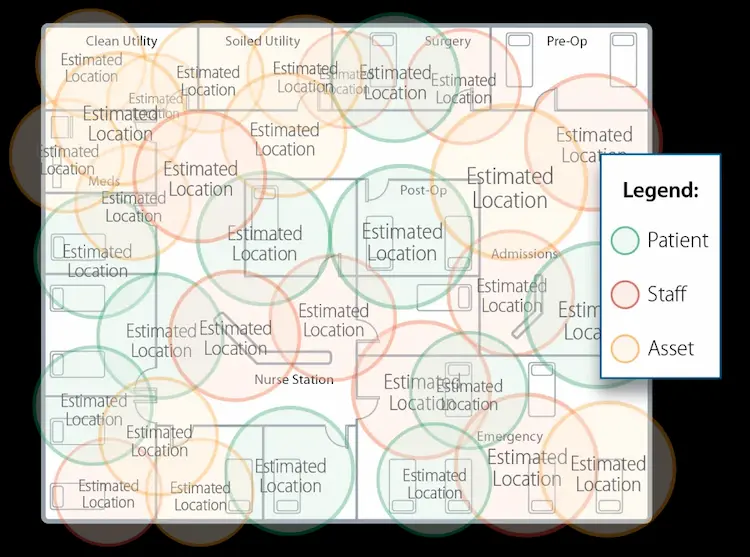
Certainty based locating of critical resources
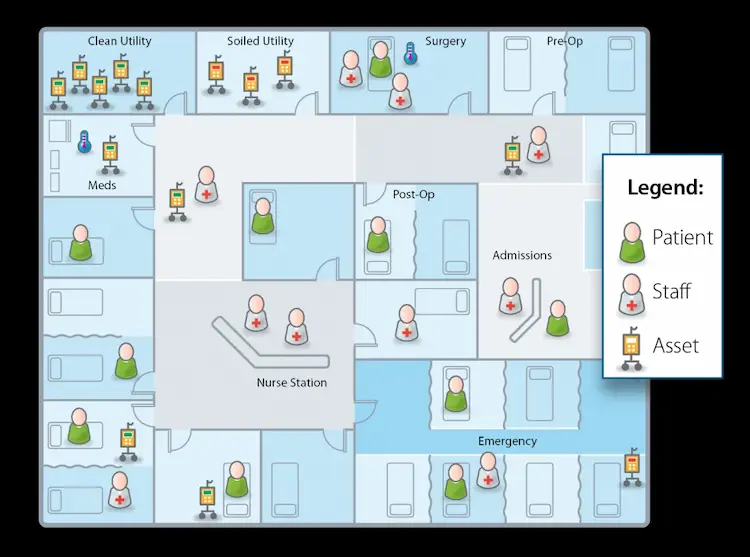
What should you consider when choosing a RTLS healthcare system
Is it stable of the vendors’ finance?
Most RTLS systems are long-term commitments. They need to buy hardware and training to ensure maximum capacity. It’s good to buy from a supplier that will be in business in the long run, update and service the infrastructure at the same time.
What are the main objectives?
Identify clear medical and business goals for the implementation of RTLS systems. Knowing the expected results enables you to find the right system and evaluate its success. Different goals require different system functions.
What are the long-term goals?
Make preparation to work your way through a complete system by prioritizing your goals. Meet immediate needs first, but use scalable components to achieve long-term goals.
What is the compatibility of the factory’s existing systems?
Employees don’t want to wear multiple badges or keep track of which interfaces provide access to which data. Layering within a building is not practical when technical systems have overlapping functions. The new system that you choose should act as an replacement or integrate with existing technology.
What is the latest technology?
As in medicine, the technology of GPS is changing. A comprehensive visibility solution that covers the entire facility and performs multiple tasks will require much time to achievement. If it is based on burn-in technology, then it will be eliminated by the time the phase is completed. Go for those innovative company that can quickly adapt to the technological environment.
How much does it cost?
RTLS systems have a variety of pricing structures. MOKOSmart’s RTLS healthcare system doesn’t require a hard connection to deploy like many other systems on the market. Hardwired systems can add significantly to the cost of deployment due to the amount of time and effort required to properly integrate the system.
Just as GPS has affected travel, the healthcare facilities operation way of RTLS is changed. With smarter RTLS deployed, any healthcare facility can operate more effectively and efficiently, resulting in better patient satisfaction and stronger prospects in finance.
Best practices of your RTLS healthcare system
Installing RTLS solution in a healthcare facility is an essential investment. There’s pain point in each facility, and no single RTLS solution is likely to address each pain point with equal efficiency and effectiveness. It will enhance patient safety, satisfaction and care when it’s done well. Actually, the RTLS healthcare solutions should not only meet the requirement of the present issue, but also be flexible enough to transform from simple location tracking to context awareness. With that being said, MOKOSmart recommends following these steps when implementing a real-time location system:
- Establish a committee within your healthcare organization to help manage the implementation of RTLS technology. Many departments will enjoy some of the benefits of the system after it is deployed, that’s why it is significant to have the support of all stakeholders. As the team is proficient in the operation and application of the system, they will be able to evaluate new RTLS opportunities and enlarge investment.
- Agree on norms. Ensure common understanding and definition of the various levels of accuracy (room, bed, compartment, chair level) and update delay requirements. Also ensure that all battery life expectations clearly document detailed assumptions related to the level of activity and speed of infrastructure updates for each tag.
- Next, create a scheme and evaluation that fits your facility. Putting a formal process in place can prioritize the most valuable applications and decrease the potentials of any unexpected distractions.
- Align the activities and goals of RTLS with your factory’s principles. By classifying your goals and plans against the system, it becomes easier to assess the effectiveness of the system and identify opportunities for improvement.
- Focus on integration and scalability. Examine the capabilities of the currently available technologies and expose gaps in capabilities that may be required to capture niche RTLS applications. Make a plan and estimation on the number of tags in the future state,ensuring that the recommended architecture supports the target use cases well in the future.
- Demonstrate the significance of the RTLS healthcare system to patients, staff and their families. People tend to feel that their privacy is intruded if the value of the system didn’t put across to them first. It’s very necessary to patiently explain the value of the technology to ensure support from all involved.
- Start with a trial in one or two departments before deploying the system facility widely. This will be helpful in ensuring that any hiccups will be relieve quickly so as not to affect the entire facility.
Multi-Mode RTLS healthcare solutions
MOKOSmart’s multi-mode RTLS technology combines UHF active RFID, Wi-Fi, second-generation Infrared positioning, low frequency RF, Bluetooth Low Power and other technologies to guarantee future investment and maximizes ROI. Monitors or virtual walls, can provide you with a unique location number and pinpoint any marker assets in a room or area defined by your organization. They can be deployed wherever needed, such as nursing stations, rooms, compartments, hallway sections, and other areas, without the need for expensive hard-wiring. Our RTLS healthcare technology also transmit location and condition information to authorized hospital staff members using your Wi-Fi network.
Open platform:
MOKOSmart’s open platform delivers location data in real time to more than 130 integrated partner applications. The platform also supports location data using Wi-Fi clients, including computers on wheels, intravenous pumps and mobile phones.
Ultimate precision, flexibility:
MOKOSmart’s Bluetooth beacons can be installed in rooms, hallways, cubicles, chairs, and other places that require accurate location data. Therefore, there is no error when the tag reads the room number. This is deterministic RTLS, which is a need of the workflow applications and healthcare automation in this era.
Bluetooth low power:
Our BLE beacon is designed for way finding applications, and BLE capability is one of many positioning technologies supported by our positioning system, providing an investment for the future.
